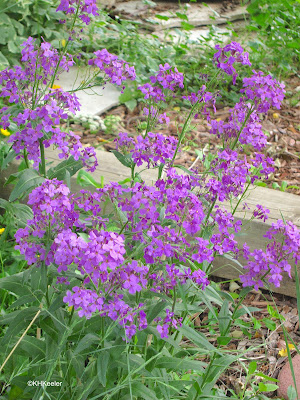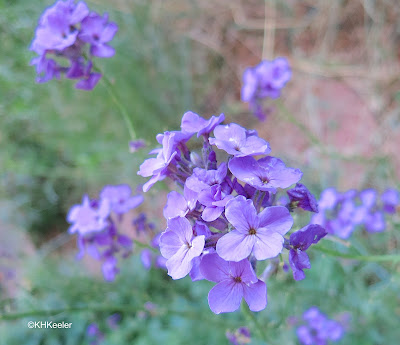 |
| dames rocket, Hesperis matronalis |
A conspicuous plant, it has numerous common names: dames rocket, dames violet, mother-of-the-evening, damewort, queen's gilliflower, garden rocket, sweet rocket and others. Apparently it became a garden plant long ago. It was one of Marie Antoinette's favorite garden flowers. Rocket is a general, old name for plants in the mustard family, and dame's rocket suggests it was grown in gentlewomen's gardens. (I want to put an apostrophe on dame's or dames' rocket, but no one does.) The species epithet, matronalis, "of matrons" also refers to it as a lady's garden plant. Hesperis, the genus, means "of the evening" because the flowers' memorable pleasant scent is released early in the evening. There are 20-60 other species in the genus Hesperis in Eurasia, but only dames rocket is listed as occurring in the United States.
Native to southern Europe, dames rocket was brought to North America by some of the first European settlers. It had been a garden plant all across Europe for centuries. The flowers range from white through pink to purple. They can be spectacular.
 |
| dames rocket, Hesperis matronalis |
Growing as garden plants, dames rockets soon escaped. Their method is to produce many seeds--one plant can produce up to 20,000 seeds--that may germinate the next spring or lie dormant in the soil a few years. Generally they don't flower until the second year and then only live a year or two more, but with abundant seed production, the populations took off. They invaded roadsides, meadows, forest glades, and disturbed sites.
They spread across the northern U.S. before 1900, so that many people thought they were native wildflowers. The situation was made worse by companies including them in wildflower mixes. The result is that they are on noxious weed lists in states from Maine to Utah. My state, Colorado, is one of them. Looking online, dames rocket seeds are readily available. Most vendors note that they cannot be shipped to some states, but a few call dames rocket or queen's gilliflower a wildflower and make no mention of its introduced, invasive status.
 |
| a big stand of dames rocket |
 |
| four petals on dames rocket |
The spicy fragrance after dark is one of its most noticeable characteristics. If you can visit a patch early in the evening, check it out.
Like most mustard family plants, they make good cut flowers. I cut bouquets when I get the chance; after all, that removes the seeds those flowers would have made.
 |
Comments and corrections welcome.
Sources
Frankie Magazine. The Language of Flowers. link (Accessed 5/14/22)
Grieve, M. 1932. A Modern Herbal. Dover Publications, New York. Online link (as rocket, garden).
Invasive Plant Atlas. Hesperis matronalis link (Accessed 5/13/22)
Midwest Invasive Species Network. Dames rocket. Michigan State University link (Accessed 5/13/22)
Strauch, B. 1996. Herbs to Know: Dames Rocket. Mother Earth Living. link (Accessed 5/14/22)
Wilder, L.B. 1974. The Fragrant Garden. originally 1932. Dover Publications, New York.
Kathy Keeler, A Wandering Botanist
More at awanderingbotanist.com
Join me on Facebook: https://www.facebook.com/AWanderingBotanist
No comments:
Post a Comment